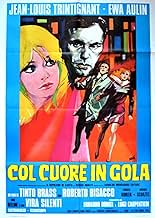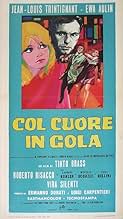Ajouter une intrigue dans votre langueBernard meets Jane at a club. Finding a blackmailer's body near her, they flee from police and a dwarf's gang. Jane's father died mysteriously, linked to her stepmother's photo. They seek he... Tout lireBernard meets Jane at a club. Finding a blackmailer's body near her, they flee from police and a dwarf's gang. Jane's father died mysteriously, linked to her stepmother's photo. They seek her brother Jerome's help.Bernard meets Jane at a club. Finding a blackmailer's body near her, they flee from police and a dwarf's gang. Jane's father died mysteriously, linked to her stepmother's photo. They seek her brother Jerome's help.
- Prix
- 1 nomination au total
Jean-Louis Trintignant
- Bernard
- (as Jean Louis Trintignant)
Skip Martin
- Dwarf
- (uncredited)
David Prowse
- Jelly-Roll's Partner
- (uncredited)
Janet Street-Porter
- Salon Receptionist
- (uncredited)
Avis en vedette
When I see Tinto Brass, I think of Cheeky and Salon Kitty. T&A features, not traditional giallo. I am willing to be surprised.
You are going to be reminded by a current jail occupant in Orlando, Fl, who was dancing the night away after her daughter went missing. The children. Jane (Ewa Aulin) and Jerome (Charles Kohler) Burroughs, in this film are in a nightclub right after they visit their father in the morgue. Guess death can't interfere with life.
Bernard (Jean-Louis Trintignant) discovers her with his dead partner and takes her away.
They go looking for the killer. It's not as bloody as most giallo, and there is no nudity to speak of, but it is worth watching. It had an almost comic book air at times, and the music was definitely upbeat.
The cinematography was outstanding on this print and really made it worthwhile.
You are going to be reminded by a current jail occupant in Orlando, Fl, who was dancing the night away after her daughter went missing. The children. Jane (Ewa Aulin) and Jerome (Charles Kohler) Burroughs, in this film are in a nightclub right after they visit their father in the morgue. Guess death can't interfere with life.
Bernard (Jean-Louis Trintignant) discovers her with his dead partner and takes her away.
They go looking for the killer. It's not as bloody as most giallo, and there is no nudity to speak of, but it is worth watching. It had an almost comic book air at times, and the music was definitely upbeat.
The cinematography was outstanding on this print and really made it worthwhile.
This pop psychedelic giallo is an early film by the Italian "master of eroticism" (he's definitely "master" of something), Tinto Brass. Unfortunately, it's VERY derivative of Michaelangelo Antonioni's "Blow-up" from the previous year, and while some find that movie borderline pretentious, this movie is well over the borderline. It also compares pretty unfavorably to the OTHER pop psychedelic giallo released in 1967, "Death Laid an Egg", which also features French actor Jean Trintigant and Swedish nymphet Ewe Aulin. But just because it isn't as good as two excellent movies like "Blow-up" and "Death Laid an Egg" doesn't necessarily make it bad. It's well filmed, and it has good acting and good music. I actually liked it better than "Salon Kitty", "Caligula" or any of Brass' other later, more erotic, but much more tedious ventures.
The story is pretty insubstantial. A man spots a a young girl at a disco and is immediately drawn to her. Later he finds the disco owner dead and the young woman standing over his body. Since the disco owner was apparently blackmailing her recently deceased father, the girl suspects that the killer might be a member of her own oddball family--her androgynous twin brother, her grasping mother, or her sinister gangster stepfather. As the couple are chased all over Swinging late 60's London by all kinds of colorful characters, including a hulking black man and a dwarf, they try to piece together the bizarro plot (while the viewers try even less successfully to do the same thing). Brass also throws in a lot of black and white footage--perhaps in an homage to American film noir--however, this style really clashes with the colorful psychedelic pop art and the principal story, which far from being downbeat and noirish, is often as light and airy as a soufflé.
Trintigant was one of the most famous French actors of the period. He was kind of in the same mold as Jean-Paul Belomondo, Jean Sorel, and Alain Delon. But he didn't seem to rely as much on his good looks as some of his fellow French leading men, and he was often in more interesting, offbeat films like Robbe-Grillet's "TransEuropean Express", "The Angry Sheep", and, of course, "Death Laid an Egg". Ewe Aulin, who was only seventeen at the time, did this film as part of a 1967 trifecta which also included "Death Laid an Egg" and the big-budget celebrity-train-wreck sex comedy "Candy". Only one of these was really a good movie, but SHE is definitely very memorable in all three of them. If nothing else, this is certainly a prime example of a European co-production of the era--an Italian film shot in London with a French leading man and a Swedish leading lady.
This is by no means a great film, but it is worth seeing.
The story is pretty insubstantial. A man spots a a young girl at a disco and is immediately drawn to her. Later he finds the disco owner dead and the young woman standing over his body. Since the disco owner was apparently blackmailing her recently deceased father, the girl suspects that the killer might be a member of her own oddball family--her androgynous twin brother, her grasping mother, or her sinister gangster stepfather. As the couple are chased all over Swinging late 60's London by all kinds of colorful characters, including a hulking black man and a dwarf, they try to piece together the bizarro plot (while the viewers try even less successfully to do the same thing). Brass also throws in a lot of black and white footage--perhaps in an homage to American film noir--however, this style really clashes with the colorful psychedelic pop art and the principal story, which far from being downbeat and noirish, is often as light and airy as a soufflé.
Trintigant was one of the most famous French actors of the period. He was kind of in the same mold as Jean-Paul Belomondo, Jean Sorel, and Alain Delon. But he didn't seem to rely as much on his good looks as some of his fellow French leading men, and he was often in more interesting, offbeat films like Robbe-Grillet's "TransEuropean Express", "The Angry Sheep", and, of course, "Death Laid an Egg". Ewe Aulin, who was only seventeen at the time, did this film as part of a 1967 trifecta which also included "Death Laid an Egg" and the big-budget celebrity-train-wreck sex comedy "Candy". Only one of these was really a good movie, but SHE is definitely very memorable in all three of them. If nothing else, this is certainly a prime example of a European co-production of the era--an Italian film shot in London with a French leading man and a Swedish leading lady.
This is by no means a great film, but it is worth seeing.
Also frantic, rambling and hyper-stylized. Tinto Brass is like a kid in a candy story in this movie, trying out every little trick in the book he can think of (split screen, black & white / color, fast cuts, fast motion, comic book inserts, etc.). Ewa Aulin is wonderful (an alternate title of the movie, I Am What I Am, sums her up perfectly), and there is also some terrific London location shooting. Plot-wise it doesn't make much sense, but I don't think it was supposed to; it is more about capturing a spur-of-the-moment spontaneity, and at that it succeeds. **1/2 out of 4.
This film is very stylized, liked a lot of the editing effects, the split images in-particular, also how it cuts to war images of Vietnam and changes to black and white in parts. The sets, costumes/wardrobe are elaborate and detailed, the lighting is very good also. Interesting to see London in the 60's, notice how the trains are still powered by steam in the scene behind the graveyard. The casting is quite strong especially Jean-Louis Trintignant who plays the lead role, he is supported by the beautiful Ewa Aulin, the cast of nefarious mob type figures is also a standout. The storyline although a little weak leaves you guessing until the end. It is quite enjoyable overall, but seems a little experimental and doesn't really mesh, but I liked the fact it had a sad ending.
Although not bad, 'Col guore in gola' is clearly inspired by Michelangelo Antonioni's 'Blow Up' -- the famous film from 1966, capturing London's young & fashionable mid-Sixties spirit with unparalleled quality. This Italian copy even goes as far as mentioning Antonioni.
'Col guore in gola's somewhat hazy plot clearly does not make this film's main attraction. It's the visuals that are prominent here, and they surely are great and inspiring. And very, yes very, mid-Sixties -- as well as a little too extended to our 21st century-taste.
Male lead Jean Louis Trintignant does not need any introduction. His performance is as usual: most competent. Female lead Ewa Aulin, reminding me of Goldie Hawn, does well, too. Together they take you through 'Col guore in gola', making you a nice watch.
'Col guore in gola's somewhat hazy plot clearly does not make this film's main attraction. It's the visuals that are prominent here, and they surely are great and inspiring. And very, yes very, mid-Sixties -- as well as a little too extended to our 21st century-taste.
Male lead Jean Louis Trintignant does not need any introduction. His performance is as usual: most competent. Female lead Ewa Aulin, reminding me of Goldie Hawn, does well, too. Together they take you through 'Col guore in gola', making you a nice watch.
Le saviez-vous
- GaffesEnglish subtitles mistranslate Earl's Court as"Burns" Court.
- ConnexionsReferences Blow-Up (1966)
Meilleurs choix
Connectez-vous pour évaluer et surveiller les recommandations personnalisées
- How long is I Am What I Am?Propulsé par Alexa
Détails
- Durée
- 1h 44m(104 min)
- Mixage
- Rapport de forme
- 1.85 : 1
Contribuer à cette page
Suggérer une modification ou ajouter du contenu manquant
























